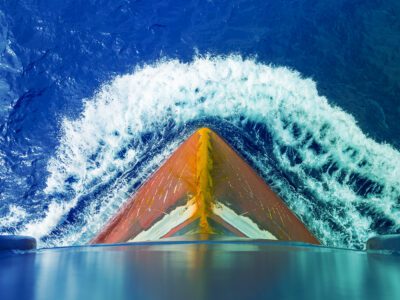Right whales may need more room

The North Atlantic right whale is critically endangered. The National Marine Fisheries Service pegs its current population at roughly 313 individuals, unchanged over the last 25 years. (Early this year there were hopeful reports of a potential rebound, or at least a very good calving season.) Right whales migrate from winter calving grounds off Florida to summer feeding grounds in New England and north. Because their migratory route hugs the busy eastern seaboard, ship strikes are the single most important threat to the population. Late last year, NMFS established some seasonal restrictions on vessel operations intended to reduce the hazards to whales near major eastern ports, but a new study suggests that the regulated areas may not be large enough to protect migrating whales.
NMFS has determined that the Atlantic right whale population is already so reduced that it cannot sustain any deaths or serious injuries at human hands if it is to recover. It is illegal under both the ESA and the Marine Mammal Protection Act to hit a right whale with a ship, but of course ship strikes are typically not intentional. Based on data indicating that both the likelihood of a collision and its risk of causing serious injury or death rise sharply with vessel speed, last December NMFS established a seasonal speed limit of 10 knots within 20 nautical miles (37 km) of major ports. Shipping interests fought the rule, which will marginally increase travel times without, they argue, acutally helping whales. NMFS responded by downsizing the restricted speed areas from the originally proposed 30 nm (56 km) and, in an unusual twist, including a five-year sunset clause and committing during that time, “to the extent possible with existing resources,” to study both ship-whale interactions and the economic impacts of the speed limit.
NMFS didn’t specify what information it would most like to have before the rule’s scheduled December 2013 expiration date. Since the data on the effects of ship strikes and the effects of speed look pretty strong already, the most important gap seems to involve where and when right whales travel. A group from Duke University is seeking to fill that gap. In a paper just published in the Canadian Journal of Fisheries and Aquatic Sciences (subscription required), they propose a new model of whale migratory routes based on satellite monitoring of two radio-tagged females. They conclude that at least some whales are migrating at a greater distance from the coast than previously believed, meaning that larger low-speed zones may be needed to protect them against ship strikes.
This work is, of course, only a starting point. The authors concede that they have tracked only two whales, but they note that two reproductively active females is a significant portion of that “most valuable segment of the population,” currently estimated to total only 97.
This example highlights the existence of key data gaps in natural resource management, not only in this case but in every controversial context. Regulatory agencies frequently must act, as they did in setting the speed limit rule, with only limited information. That’s always politically difficult if action has economic consequences, because the agency cannot guarantee that the economic costs will be balanced by corresponding environmental benefits. In cases like this one, where even one ship strike, especially on a pregnant or nursing female, could be too much for the species to tolerate, the agencies must be able to take a precautionary approach to regulation, implementing protective rules even without conclusive evidence that those rules are either necessary or sufficient to meet the conservation goal. At the same time, it makes sense to characterize those rules as tentative, although a sunset provision, which makes the species take the risk of future inaction or political gridlock, is probably not the best way to do that. It would also make sense for the agency to be more explict about what sorts of information would be most helpful to its ongoing regulatory task, and for the nation to direct more of its research funding to groups willing and able to seek that needed information.
(Hat tip: Science Insider.)







Reader Comments